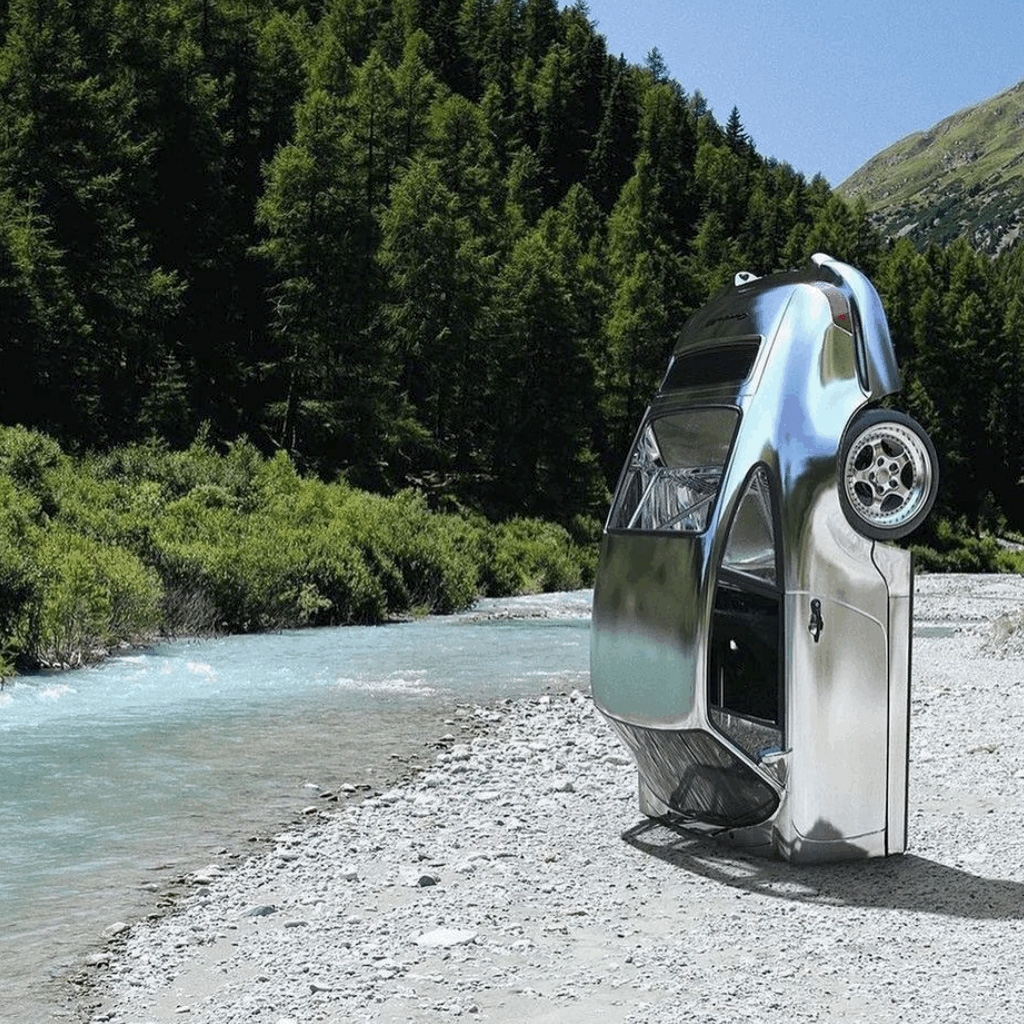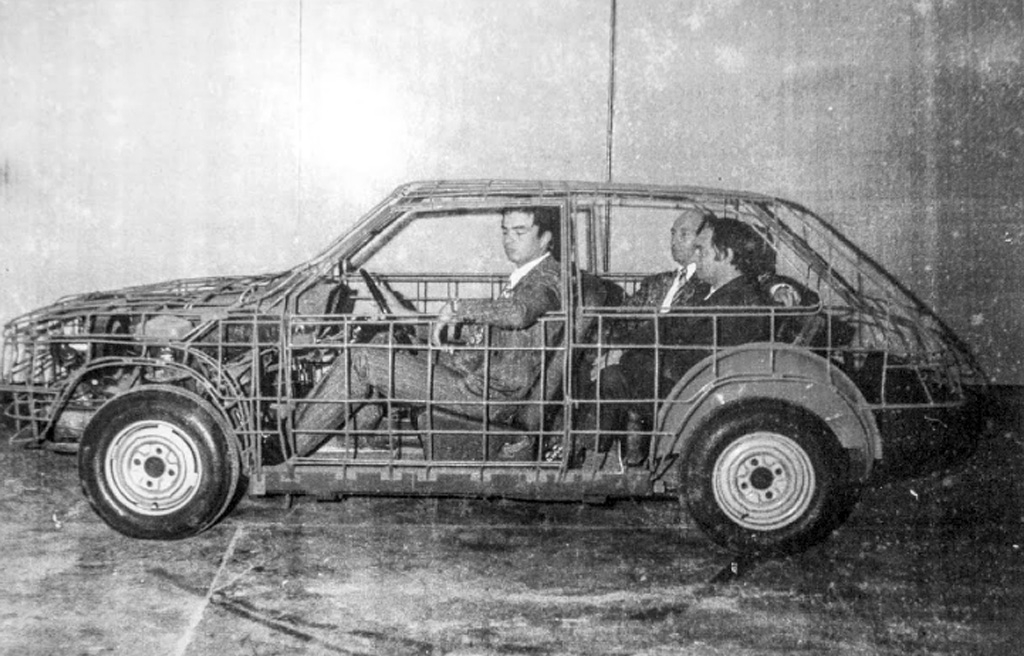RESEARCH
AUTOPOIETIC
A Creative Observatory Towards a Mobile Revolution Where the City Itself is Changing into an Utopian Place
It seems that architects concern themselves with car design, but the car has been in architects' imaginations, appearing as a life on wheels, a mobile home. Architects recognized that its image, form, and function affect the quality of space, which could be a synthesis of extending spatial conceptions. Lately, the result of harmonizing the composition of two elements has stressed their close affinity and made architecture strongly influential in car design. Car designers realized the importance of architecture in applying spatial integrity to their designs.
The connection between man and machine forms various spatial dimensions when this evolution materializes through numerous sensorial perceptions and idiosyncratic structures. While the car exists in spatial integrity, it is also being led to be integrated with architecture as an abstract unit. While generating new reinterpretations of modern life, cars form cognitive structures. This century-long relationship indicates a spatial integrity beyond being just an object; a car hosts a life that forms us as much as it deforms. We are fully aware of the fact that a car is not the presence of fixed elements; it is an imagination. The architectural transformation of cars would be assessed to predict our next steps, which can be seen as interventions to future life conjunctures and design postures.
This extraordinary bond between man and machine has reformed the sense of time and sustained an irresistible journey. Traveling refers to a spatial experience that is indefinite, cyclic, and continuous. The quote of the car that represents separation, transition, and integration through space means an independent architectural unit, yet the car has formed one of the most dramatic spatial paradigms and added a mobile but paradoxical transition to architecture. Today, the spatial concept of the car has made it more difficult than ever to define its dimensions, which the research mainly aims to explore.
What if home as an architectural unit would merge into a car to incorporate mobile and immobile elements in the experimental process of livability? What if a car that could also be used after the journey as a conclusive archetype following its extensively modified context? What if the pro-activating ‘life on the move’ concept would demonstrate new car typologies that could be a part of future urban morphology since throughout history cars have redefined the city. There has always been a sharp distinction between architects, urban planners, and car designers; this may disappear if projects merge these disciplines through a creative process that the research is intended to exhibit.
Looking at how various design concepts and objectives have been used between architecture and car design is valuable since each can learn a great deal from the other. Working by contemporary car designers and design students would illustrate how this has occurred and how it might be furthered in future models, wherein the research is particularly interesting. This interdisciplinarity will be a synthesis of two disciplines and establish a new level of discourse and integration of knowledge that can create new disciplines towards a coordinated and coherent whole.
Methodology
The research aims to create a creative as well as an intellectual experience in interdisciplinary approaches and collective consciousness. The process will cultivate a balanced combination of hypothetical information transferred from applied projects provided by professionals and design students. To have an experimental methodology for the research, the projects will be discussed in speculative manners; therefore, the final project might deal with utopic, dystopic, and heterotopic design conjunctures that can inform future mobility. For the final project, it is aimed at manifesting a form of life (semiotic archetypes) that borrows different qualities from architecture and car design.
The research involves a set of projects; it is not thesis-only. What will be created are the context, visualizations, and models of the proposed models. The research will involve interactions with the students studying architecture, art, communication, and design, particularly those who are studying intelligent mobility design. Projects will draw out the sense of the future that can be experienced within the unseen and unknown. The abstract nature and experimental diagnostics of the proposed projects intend to reflect future configurations of mobility.
The research is interested in creative processes, which will apply design as research. It will use lateral, intuitive, and creative methods driven by application, which means a design that questions the context of application. In this research, ‘through’ design takes design processes to constitute the research methodology as ‘practice-led’ research. Research ‘through’ design produces more debate by being further developed in discussions between theory and practice. (Frayling C., RCA 1993, puts a tripartite model of ‘into’, 'through', and ‘for’ to clarify the complex set of relationships between design and research.)
Questions and arguments
Architecture incorporates knowledge of other disciplines like car design that is fertile for interdisciplinarity; both disciplines are similarly shaped by the concept of space and spatial formation. Several interventions, including new conceptual frameworks, provide a motive to identify car design as a discipline connected to architecture; however, locating unique ‘architectural’ statements for the car continues to be problematic. This argument advances this debate towards recent changes in mobility and understanding car design as a movement for societal as well as morphological change in urban context. In particular, car design, at the intersection of architecture and design, emerges as a new way of constructing architectural and designer knowledge.
The research will go through several questions:
. Seeing the creativity of car designers and design students gives an insight from their vision about how the context of the car may evolve into architecture in a future model.
. How these models can establish a symbiotic relationship based on mutual benefit and how spatial transition can be considered as a common denominator in the hyper-connected future city paradigm.
. Questioning what are the architectural progresses and how these will affect the evolution of the car and shaping its intended use. Questioning what additional functions cars might have beyond transportation.
. What appears to have been produced by a car designer under closer investigation reveals itself to have been made by an architect. What defines a car as design and the other as architecture? Is it possible to have a definition of design that includes both?
. Questioning the changing role of car designers towards architecture.
Outcome
Most studies reflect an understanding of architecture and cars as discrete disciplines interacting in passive and unilateral manners. This dominant approach is concluded to be the essential cause of the ‘implementation gap' between mobile and immobile structures. For the gap to close, the development of a critical framework is needed that encourages researchers to acknowledge explicitly ontological and epistemological issues associated with car design practice, education, and research. Underlying this recommendation is a dialectic appreciation of man-machine interaction over the car, which means spatial, experiential, and interpretative qualities of human kind and emotions.
Car design takes place in a broad societal and cultural context, connecting academia and practice as well as architecture. A clarification of this position is necessary to stimulate stronger links between these disciplines in theoretical and practical manners. In both contexts, architecture and car design, interdisciplinarity will support projects directly through future mobility and continual advancements. Future architects and car designers need to be able to establish basic premises, perform critical analysis, conduct intensive research, and propose syntheses independently for better mobility at both the personal and public levels, which includes installations, experimental projects, proposals, models, and artifacts. Considering the current path that the car industry has been going through, it would easily prove that the next few decades will bring major changes. Aiming to transform the idea behind the car will create new archetypes based on personal and social consequences; as a result, car designers will have to demonstrate holistic vision to achieve a car that is beyond preconceptions and set typologies.
In the last few decades, blurring the boundary between reality and fiction has become a subject that has become increasingly popular within new academic fields of future studies. In fact, the concept of faction, a hybrid concept between documentary and fiction, or reality and fiction, is a product of this process. We are going through a period in which the boundaries of both life and forms are blurred; it is getting hard to define what is real and what is fiction. Apart from functionality, future mobility is ambiguous, uncertain, but also fascinating. We should move to a new academic research model where creativity is an important change.
In academic thinking, there should be a space for rather speculative design, not always direct use of the research outcome. Designers should seek new ways of thinking and new experiments for making and participating themselves more freely. We don’t have to rely on change to come; we can create it ourselves through activism to avoid fake realities. This is happening in the field of future mobility as a call to action through imagination, so that we can re-construct the relationship with the world and create solutions for the future.
Conceptual design projects, especially those not designed to be built, might produce knowledge that questions rather than affirms. This research will provide possibilities for extending and critiquing the profession through conceptual designs and a chance to reflect upon what is there, but also to imagine something different, to question and transform rather than describe and affirm. This avoids the science/art and qualitative/quantitative splits and allows freedom.
WHAT DOES CREATIVE OBSERVATORY MEAN?
Extended Content for the Research Proposal
The research is interested in the interconnected nature of mobility and, within this context, how architecture, art, communication, and design would distort our perception of the future. The process will engage with creative experiences and aim to discuss common narratives on how our current conception of mobility is actually structured around fixed elements. The research will focus on a future world that is closer than ever and mobility that is being re-thought over utopic, dystopic, and heterotopic possibilities. Interdisciplinarity brings an urge for critical positioning to the research to generate new creative formations and explore ways to open discussions on what it means to be mobile in future environments.
As an outcome, the research will exhibit creative experiences as a documentary towards future mobility, whether visualized, written, recorded, or sculptured through images, text, motion, sounds, or even performances. For the research, provoking concepts are not only essential but can map the moving landscape of the future. The works presented in the final exhibition are considered artifacts that offer evidence of the evolving ideas that form the foundation of future mobility through observation.
The main research question asks how design-based research would facilitate content through observation, and continued questions ask how creativity speculatively can be used as a tool to investigate future predictions through design practice and through which framework design would inform research on future mobility. It claims to understand how creativity can be cumulatively used as an instrument for conjectural knowledge on a path rooted mainly in architecture, art, communication, and design for experimentation, documentation, and critique.
The research will be contextualized by the relations between mobile and immobile structures that are identified as life forms and processes through design to generate potential for the future. This includes a projection where the research unpacks the historical genealogies of utopias from Archigram. This application materializes historical reflections about how such genealogies might be conceptualized to facilitate visual production. Revisiting historical prototypes of utopias and using them to question the boundaries between architecture and mobility will automate new versions of these proposals.
The Creative Observatory is a critical study for design and practice-based research that integrates future thinking, perceptual experiences, and creative interdisciplinary inquiry. It aims to cultivate expanded perspectives and re-imagine mobile futures. It emerges from the mutuality of life and mobility, which is the foundation of the theoretical investigation. Observation is the primary method applied in this practice-based research and is defined as perceptual interaction with the participants.

